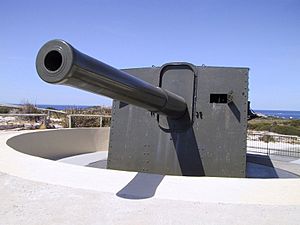Challenger Battery facts for kids
Quick facts for kids Challenger Battery |
|
|---|---|

A Canon de 155mm GPF of the Challenger Battery
|
|
| Location | Entrance Point, Garden Island, Western Australia |
| Official name: J Gun Battery | |
| Type | Listed place (Historic) |
| Designated | 22 June 2004 |
| Reference no. | 105272 |
| Official name: Challenger Battery | |
| Type | City of Rockingham Heritage List |
| Reference no. | 3301 |
| Lua error in Module:Location_map at line 420: attempt to index field 'wikibase' (a nil value). | |
The Challenger Battery, also known as J Gun Battery, is a special historic site. It's located at Entrance Point on Garden Island in Western Australia. This battery was an important part of Australia's defenses during World War II. It helped protect Fremantle Harbour from enemy attacks.
The battery has had a few names over time. It was first called Garden Battery, then Entrance Battery, and finally Challenger Battery. It was officially added to the Australian Commonwealth Heritage List on 22 June 2004.
Contents
Protecting Fremantle: The Fremantle Fortress
In the mid-1930s, the Australian Government decided to make its coastal defenses stronger. This was to protect major ports from possible enemy attacks. Protecting Fremantle Port in Western Australia was a top priority.
To do this, old batteries were upgraded, and new ones were built. Places like Leighton and Swanbourne had their defenses improved. New batteries were also planned for Garden Island and Rottnest Island.
All these defenses together were called the Fremantle Fortress. The main goal was to stop enemy ships from getting close enough to bomb Fremantle Port. Large 9.2-inch guns were placed on Rottnest Island. These guns could fire up to 28 kilometers, hitting enemy ships before they could reach Fremantle. Protecting Fremantle Port was seen as vital for Australia's safety during a war.
Other batteries with smaller 6-inch guns were also set up. These were at Rottnest Island (the Bickley Battery), Arthur Head, and Fort Forrest. By the start of World War II, many of these batteries were ready for action.
History of the Battery
The Challenger Battery complex included a strong magazine bunker. This bunker was made of brick with concrete floors and a roof. It stored ammunition safely. The bunker was divided into two parts, one for each gun.
The battery had two gun mounts for its 155mm guns. These mounts had a central concrete base and a special ring that allowed the guns to turn. Like many other coastal defenses in Australia, these guns were removed by 1963.
The Challenger Battery is a key part of the surviving defenses from World War II. It shows how important Cockburn Sound and Fremantle were to protect.
The Challenger Battery in Action
Challenger Battery is located at Entrance Point, at the very north-west tip of Garden Island. As mentioned, it was known by several names, including J Gun Battery. The "J" and "K" names were used to identify new batteries.
When General Douglas MacArthur arrived in Australia in March 1942, protecting Australian ports became even more urgent. A report in May 1942 suggested building two new 155mm batteries. One was to be on Garden Island (Challenger Battery, or J Battery), and the other at Cape Peron (Peron Battery, or K Battery). These batteries also had searchlights to help guard the area.
Challenger Battery was the first gun battery built on Garden Island in 1942. It used two mobile 155mm guns supplied by the US. These guns were placed on special mounts called Panama mounts. They were installed to protect Garden Island, Cockburn Sound, and the Challenger Passage.
The battery was ready and working by April 1943. Later, more permanent batteries were built on the island, finished by October 1943. The Challenger Battery's guns were removed in December 1944.
Two other batteries were also built nearby. The Beacon Battery was completed in the same year, located near J Gun Battery. The Scriven Battery was planned earlier but only finished in mid-1945, becoming operational after World War II ended.
Why Challenger Battery is Important
Challenger Battery (J Gun Battery) is very important because it was the first gun battery built on Garden Island. It played a big role in protecting Cockburn Sound and Fremantle after Japan joined World War II.
The gun mounts and the magazine building show how coastal gun batteries were built during World War II. They also show how batteries were placed to create overlapping firing zones, protecting a wide area. For example, the magazine building used strong reinforced concrete and a special double-wall system for safety.
Challenger Battery was listed on the Australian Commonwealth Heritage List on 22 June 2004. This listing recognizes its historical importance and its design features. It helps us understand the coastal defenses of Australia during a crucial time in history.
Images for kids



